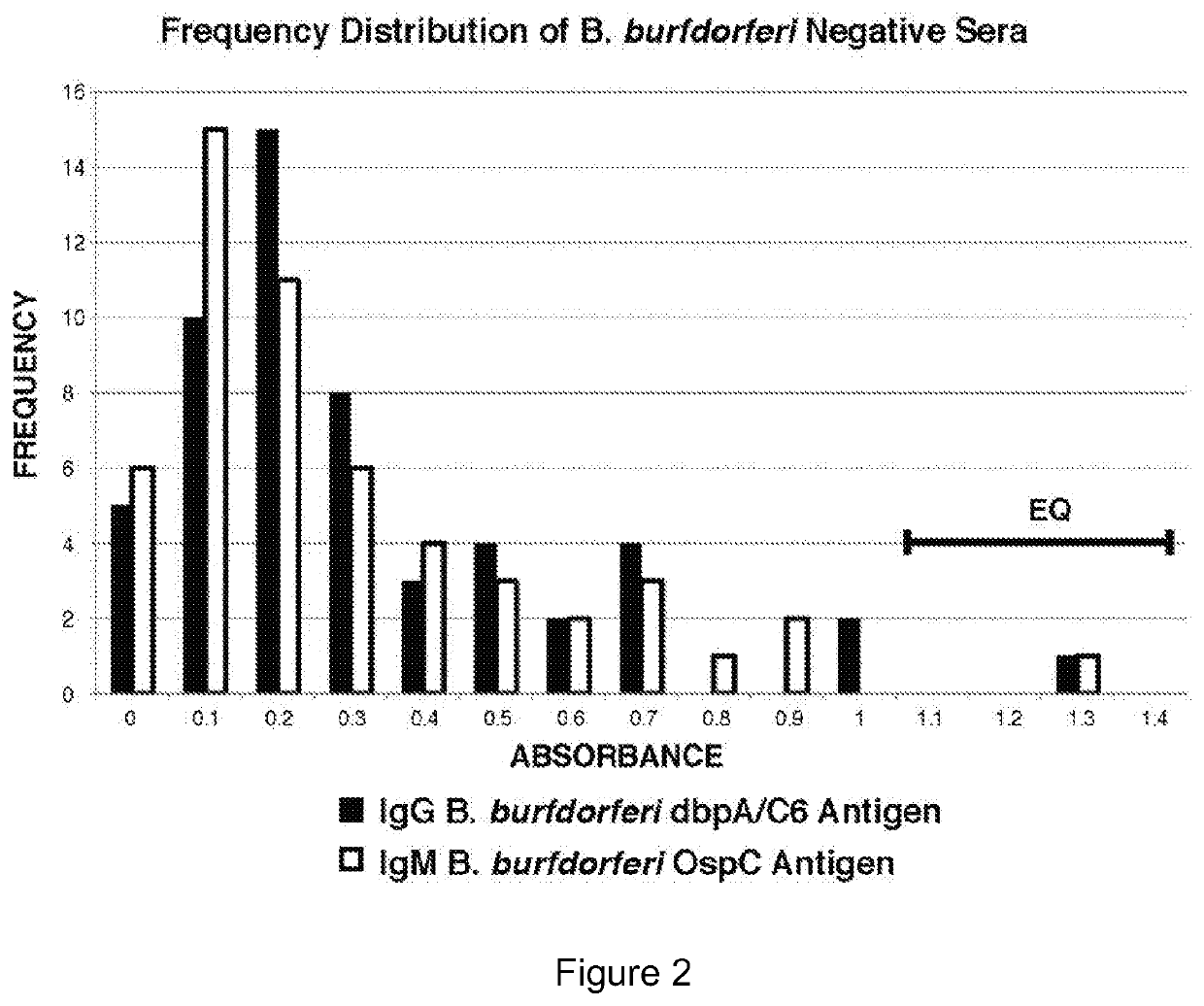Serodiagnosis of Lyme disease by use of two recombinant proteins in ELISA
a technology of lyme disease and serodiagnosis, which is applied in the field of diagnosis of lyme disease, can solve the problems of difficult to detect spirochetes by direct detection, unreliability, and technical complexity of western blot assays, and achieves the effects of improving detection accuracy, reducing detection errors, and reducing detection errors
- Summary
- Abstract
- Description
- Claims
- Application Information
AI Technical Summary
Benefits of technology
Problems solved by technology
Method used
Image
Examples
example 1
[0055]Cloning of B. burgdorferi Genes:
[0056]Borrelia burgdorferi strain B31 cells were from MarDx Diagnostic, Inc. (Carlsbad, Calif.). E. coli BL21(DE3) pLysS One Shot and Top10 Chemically Competent Cells were purchased from Invitrogen Life Technologies (Carlsbad, Calif.).
[0057]DNA and RNA were extracted from pelleted B. burgdorferi cells using the DNeasy or RNeasy Kits, respectively, from QIAGEN Sciences, Inc. (Germantown, Md.) according to the manufacturer's instructions. Primers for the PCR reactions (Table 6) were purchased from the University of Utah Cores Labs (Salt Lake City, Utah). Each of the primers was 33 nucleotides in length. The first 12 nucleotides at the 5′ end of each primer specified restriction sites, and nucleotides 13-33 were specific for the selected gene being amplified. PCR reactions were carried out using the SuperScript III One-Step RT-PCR or the Platinum Taq DNA Polymerase High Fidelity kits from Invitrogen Life Technologies.
[0058]
TABLE 6Primers used in th...
example 2
[0061]Recombinant Protein Expression and Purification.
[0062]Expression plasmid DNA was purified using the QIAfilter Plasmid Midi kit from Qiagen (Valencia, Calif.), transformed into chemically competent BL-21(DE3) pLysS cells as directed by the manufacturer (Invitrogen Life Technologies, Carlsbad, Calif.) and grown overnight on LB agar plates containing 100 μg / ml of ampicillin. Transformed colonies were harvested into LB medium and used to inoculate 3×2 liters of LB medium containing ampicillin in 3-liter baffled flasks. The flasks were rotated at 120 RPM for 4-5 hours at 37° C. until the turbidity reached approximately 0.8 OD600 units. Recombinant protein expression was induced with the addition of IPTG to 1 mM, and the flasks were incubated with shaking for 2 hours. Cells were concentrated by centrifugation, washed once in PBS, and suspended in 35 ml of Binding Buffer (20 mM Sodium Phosphate, 500 mM Sodium Chloride, pH 7.8) containing 7M Guanidine-HCL and set at −80° C. The suspen...
example 3
[0063]Protein Determination and SDS-PAGE:
[0064]Total protein was determined by the Bradford Method, Bradford, M., Protein reaction with dyes, Anal. Biochem. 72:241-247 (1976), using dye and Bovine Gamma Globulin standards from Bio-Rad Laboratories (Hercules, Calif.). SDS-PAGE analysis was carried out using Invitrogen Life Technologies NuPAGE 4-12% Bis-Tris precast polyacrylamide gels and run on their Novex Mini-Cell electrophoresis apparatus. Separated proteins were stained with 0.25% Brilliant Blue R (Sigma Chemical Co., St. Louis, Mo.).
PUM
| Property | Measurement | Unit |
|---|---|---|
| molecular weight | aaaaa | aaaaa |
| concentration | aaaaa | aaaaa |
| molecular weights | aaaaa | aaaaa |
Abstract
Description
Claims
Application Information
 Login to View More
Login to View More - R&D
- Intellectual Property
- Life Sciences
- Materials
- Tech Scout
- Unparalleled Data Quality
- Higher Quality Content
- 60% Fewer Hallucinations
Browse by: Latest US Patents, China's latest patents, Technical Efficacy Thesaurus, Application Domain, Technology Topic, Popular Technical Reports.
© 2025 PatSnap. All rights reserved.Legal|Privacy policy|Modern Slavery Act Transparency Statement|Sitemap|About US| Contact US: help@patsnap.com


